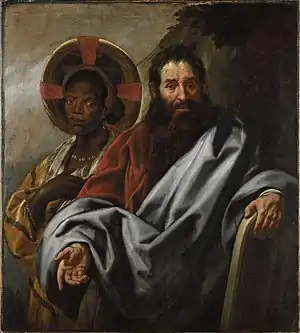Sybil Agrippina
The Sibyl Agrippina is a circa 1630s oil painting of a Black woman in the guise of the Sibyl Agrippina (also known as Sibyl AEgyptia). The painting is one of a series of Sybils by Jan van den Hoecke, only recently being re-attributed after being known as an early portrait of an African woman by Abraham Janssens. It is held in the Museum Kunstpalast in Düsseldorf.[1]
| The Sibyl Agrippina | |
|---|---|
| Sibyl Agrippina | |
 | |
| Year | c. 1630s |
| Dimensions | 1,065 mm (41.9 in) × 800 mm (31 in) |
The motif of a Black woman as "Egyptian" Sybil follows the style of various engravings of sybils in Western religious art. The Sybil is shown here with a whip and a crown of thorns, both attributes of Christ's Flagellation. It was given the Jan van den Hoeke attribution in the 2008 exhibition Black is beautiful: Rubens tot Dumas by prof. Elizabeth McGrath. The inscription reads Siccabitur ut folium (he will be shrivelled like a leaf).[2]
 Sybil Agrippina, by Jan Luyken
Sybil Agrippina, by Jan Luyken Sybil Agrippina, by Crispijn van de Passe
Sybil Agrippina, by Crispijn van de Passe Moses and his Ethiopian wife Sephora, by Jacob Jordaens
Moses and his Ethiopian wife Sephora, by Jacob Jordaens
References
- Painting in blogpost by Esther Schreuder, curator of Black is Beautiful
- Latin verses regarding the "Sybilla Agrippa" in "As David and the sibyls say", sketch of the sibyls and the sibylline oracles by Mariana Monteiro, Alfred Canon White, 1905
- Black is beautiful: Rubens tot Dumas, catalog nr. 22, exhibition & catalog in Nieuwe Kerk Amsterdam, 2008
- "Jacob Jordaens and Moses's Ethiopian Wife", by Elizabeth McGrath, Journal of the Warburg and Courtauld Institutes 70, 2007, pp 247-85